A study on the behavior and colonization of translocated Greater One-horned Rhinos Rhinoceros unicornis (Mammalia: Perissodactyla: Rhinocerotidae) during 90 days from their release at Manas National Park, Assam India
Deba Kumar Dutta 1 & Rita Mahanta 2
1 WWF‐India, Parvati Nagar, P.O. Tezpur, Assam 784001, India
2 Associate Professor (Retd.), Department of Zoology, Cotton College, Guwahati, Assam 781001, India
1 debakumerdutta@gmail.com (corresponding author), 2 ritamahanta@yahoo.co.in
doi: http://dx.doi.org/10.11609/JoTT.o4024.6864-77
Editor: Kees Rookmaaker, Rhino Resource Center, United Kingdom. Date of publication: 26 February 2015 (online & print)
Manuscript details: Ms # o4024 | Received 08 May 2014 | Final received 06 February 2015 | Finally accepted 09 February 2015
Citation: Dutta, D.K. & R. Mahanta (2015). A study on the behavior and colonization of translocated Greater One-horned Rhinos Rhinoceros unicornis (Mammalia: Perissodactyla: Rhinocerotidae) during 90 days from their release at Manas National Park, Assam India. Journal of Threatened Taxa 7(2): 6864–6877; http://dx.doi.org/10.11609/JoTT.o4024.6864-77
Copyright: © Dutta & Mahanta et al. 2015. Creative Commons Attribution 4.0 International License. JoTT allows unrestricted use of this article in any medium, reproduction and distribution by providing adequate credit to the authors and the source of publication.
Funding: None.
Competing Interest: The authors declare no competing interests.
Authors Details: Deba Kumar Dutta is a senior project officer of WWF-India and has been providing technical support on rhino monitoring and research activities to translocated rhinos at Manas National Park since the year 2008. He is also an IUCN-AsRSG (Asian Rhino Specialist Group) accredited instructor in monitoring the greater One-Horned Rhino (GoH). Dr. Rita Mahanta is a retired Associate Professor, Department of Zoology, Cotton College, Guwahati, Assam. Under her, 16 research scholars have completed their PhD research. She has published more than 45 scientific research papers. She was the ex-coordinator of the Department of Bio-Technology (DBT) sponsored Bio informatics Centre & Bio-technology Hub of Cotton College, Guwahati, Assam.
Authors Contribution: DKD has contributed to the field studies as well as the scientific analysis and the write up. RM has contributed to some scientific analyses in this paper
Acknowledgement: The authors duly acknowledge the Government of Assam, Task Force and all the members of the Rhino Translocation Core Committee (TCC) and Chief Wildlife Warden of Assam. Thanks are also due to Mr. R.P Agarwalla (PCCF, WL), Mr. M.C. Malakar (Retd PCCF, WL) Mr. Suresh Chand (Retd. PCCF, WL), Mr. S.S. Rao (CCF, WL), Mr. Ravi Singh CEO and Secretary General of WWF-India, Dr. Dipankar Ghose Director, Species and Landscape Programme WWF-India, Dr. A. Christy Williams, WWF-International, Mr. H. Choudhury and Mr. Jayanta Das from WADWT; and Mr. G.C. Basumatary (CHD Forest, BTC), Mr. A. Swargowari (Field Director Manas Tiger Reserve) and Mr. Khampa Borgoyari (Deputy Chief BTC), for their continued support, encouragement and advice. The authors also acknowledge the International Rhino Foundation (IRF) and USFWS. Last but not the least we thank the dedicated efforts of the officers and frontline staff of Manas National Park, the conservation volunteers, the home guards, fringe villagers and members from the WWF team especially Dr. Anupam Sharma (Head of Assam Landscape, WWF-India) and Mr. Amit Sharma (Rhino co-ordinator, WWF-India) and all our field colleagues in Assam who were always ready with a helping hand. The literature cited is accessible on the Rhino Resource Center (www.rhinoresourcecenter.com).

Abstract: Under the Indian Rhino Vision 2020, 18 wild Greater One-horned Rhinos Rhinoceros unicornis were translocated from two rhino bearing areas, Kaziranga National Park and Pobitora Wildlife Sanctuary to Manas National Park within the state of Assam, from 2008 to 2012. Following the release, the rhinos were closely monitored through radio tracking and direct observation to record their colonization pattern and behavioral adaptation to the new environment. Out of the 18 rhinos released at Manas, 16 (89%) rhinos dispersed in approximately the same direction from the release sites. The rhinos released from Pobitora Wildlife Sanctuary strayed more when compared to the rhinos from Kaziranga National Park. This paper describes the behavior patterns observed in Manas National Park, which may provide a useful alternative approach for future rhino translocation.
Keywords: Behavior, colonization, Greater One-horned Rhinoceros, Manas National Park, Rhinoceros unicornis, translocation.
Introduction
Translocation is the intentional release of an animal to the wild in an attempt to establish, reestablish or augment the population, (Griffaith et al. 1986). Rhino translocation for conservation purposes aims to further demographic and/or genetic rhino conservation goals and in so doing contribute to ensuring the long-term survival of rhino species and subspecies in viable populations in natural habitats throughout its historical range. Translocations may be undertaken to minimize the potential for loss of genetic diversity (Emslie et al. 2009).
Until the 1980s, six protected areas in Assam had breeding populations of Greater One-horned Rhinos (GOH) Rhinoceros unicornis. However, an armed insurgency problem, which led to a breakdown of law and order in Assam, resulted in the extermination of rhinos from Laokhowa Wildlife Sanctuary, Bura-Chapori Wildlife Sanctuary and Manas National Park (MNP) by the end of the 1990s leaving only three sites with rhinos (Dutta et al. 2012). Among the remaining populations of rhino in Nepal and India, only two sites had numbers in excess of 100 individuals, thus increasing the risk to the overall status of GoH (Foose & van Strien 1997).
The Department of Environment & Forests, Government of Assam clearly realized the dangers of having most of its rhinos at one site and thus was open to implementing a pro-active management strategy for rhinos in the state. The government of Assam, with support from International Rhino Foundation (IRF), World Wide Fund for Nature (WWF) and the United States Fish & Wildlife Service (USFWS), therefore, launched the Indian Rhino Vision (IRV) 2020 to help maintain existing rhino populations and to re-introduce rhinos into protected areas from which they were exterminated in the recent past. The program aimed at achieving a population of 3000 rhinos in Assam by the year 2020 spread over seven Protected Areas (Dutta et al. 2012). As a part of IRV 2020 program, 18 rhinos were translocated to MNP from Pobitora Wildlife Sanctuary (PWS) and Kaziranga National Park (KNP) from April 2008 to March 2012 (Sharma et al. 2012).
There were four rescued rhinos rehabilitated in MNP within a 600 acre solar electric fence enclosure (Fig. 1). Rhinos were rescued in KNP when they were about one to five months old during the flood season. The calves were hand reared and nursed at the Centre for Wildlife Rehabilitation and Conservation (CWRC) with the aim of releasing them to natural habitats. At the age of about three years the calves were translocated to MNP and rehabilitated (Barman et al. 2014) (Table 1). We have observed an association of wild rhinos (R1 &R2) with these rehabilitated rhinos (Images 1 & 2).
The first three months post-release is the most critical for rhinos to settle down in a new habitat. It is strongly recommended that intensive post-release monitoring for 3–12 months should be undertaken immediately after release and during the settling-in phase (Emslie et al. 2009). However, the behavior of rhinos post release has never been intensively monitored on any translocation programme (Gottert et al. 2010). The primary goal of this study was to examine species specific exploration behavior and the colonization pattern of all 18 rhinos in their new home during the first three months following release, and its influence on park management.
Study Area
The study was carried out in Manas National Park, one of India’s UNESCO World Heritage Sites in India. MNP is situated between 26030’–27000’N and 91051’–92000’E (Fig. 2). It is located in the foothill zone of Himalaya in the northern bank of Brahmaputra Valley and falls within the newly created districts of Chirang and Baksa along the international boundary between Indo-Bhutan and Assam, India. The biological richness of the Northern Bank Landscape (NBL) of the Brahmaputra has been recognized by WWF and it is one of the Global 200 eco-regions of importance (Olson et al. 2002). MNP is famous for its rich floral and faunal biodiversity including species such as Tiger Panthera tigris tigris, Pygmy Hog Sus salvania, Golden Langur Trachypithecus geei, Hispid Hare Caprolagus hispidus, Bengal Florican Houbaropsis bengalensis and White-winged Wood Duck Cairina scutulata. MNP has a good rhino habitat and had more than 100 rhinos until the mid-1990s (Lucy & Martin 1994).
The beginning of the management history dates back to 1905, when the area was declared as North Kamrup Reserved Forests, and later in 1928 the 361km2 area was named as ‘Manas Game Sanctuary’. From 1951 to 1955, the area was increased to 391km2. The Manas Tiger Reserve (2837km2) was included as one of the first eight tiger reserves declared in the country under Project Tiger in 1972. Within the sanctuary, 391km2 was designated as a core area. The sanctuary area was also inscribed in the list of World Heritage Sites in 1985 because of its outstanding universal value. Manas, a site of outstanding universal value, under the UNESCO Natural criteria: (vii), (ix) and (x). MNP has been evaluated to meet these outstanding values on the following basis:
(vii) The reserve contains superlative natural features of exceptional natural beauty in terms of its scenic attraction of forested hills, alluvial grassland and semi evergreen forests. (Image 3)
(ix) The Manas River is an outstanding example of geological process and biological evolution with its huge depositional load and shifting river channels.
(x) Manas provides a critical and viable habitat for more rare and endangered species than any other of the Indian Subcontinent’s protected areas. It is the only and best remaining natural area where sizable populations of several species can continue to survive (Guy & Lethier 2008).
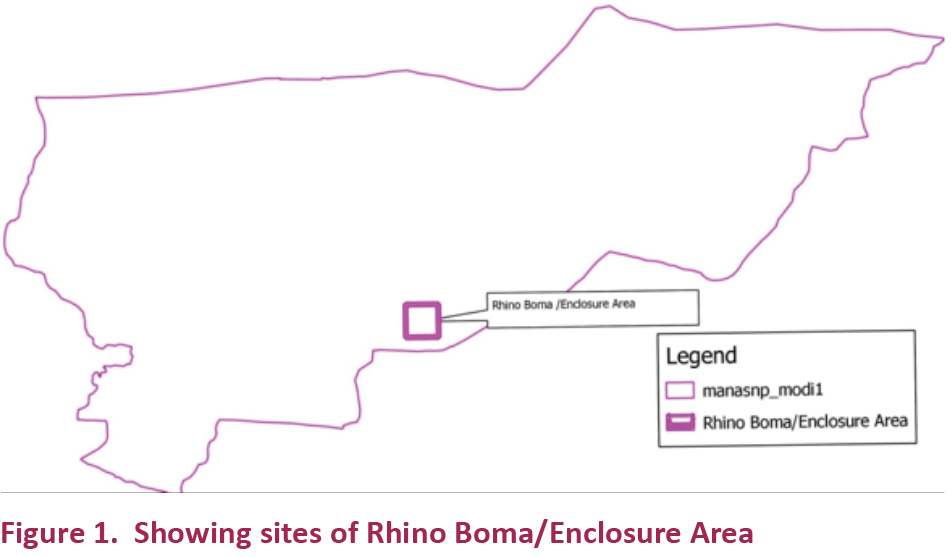
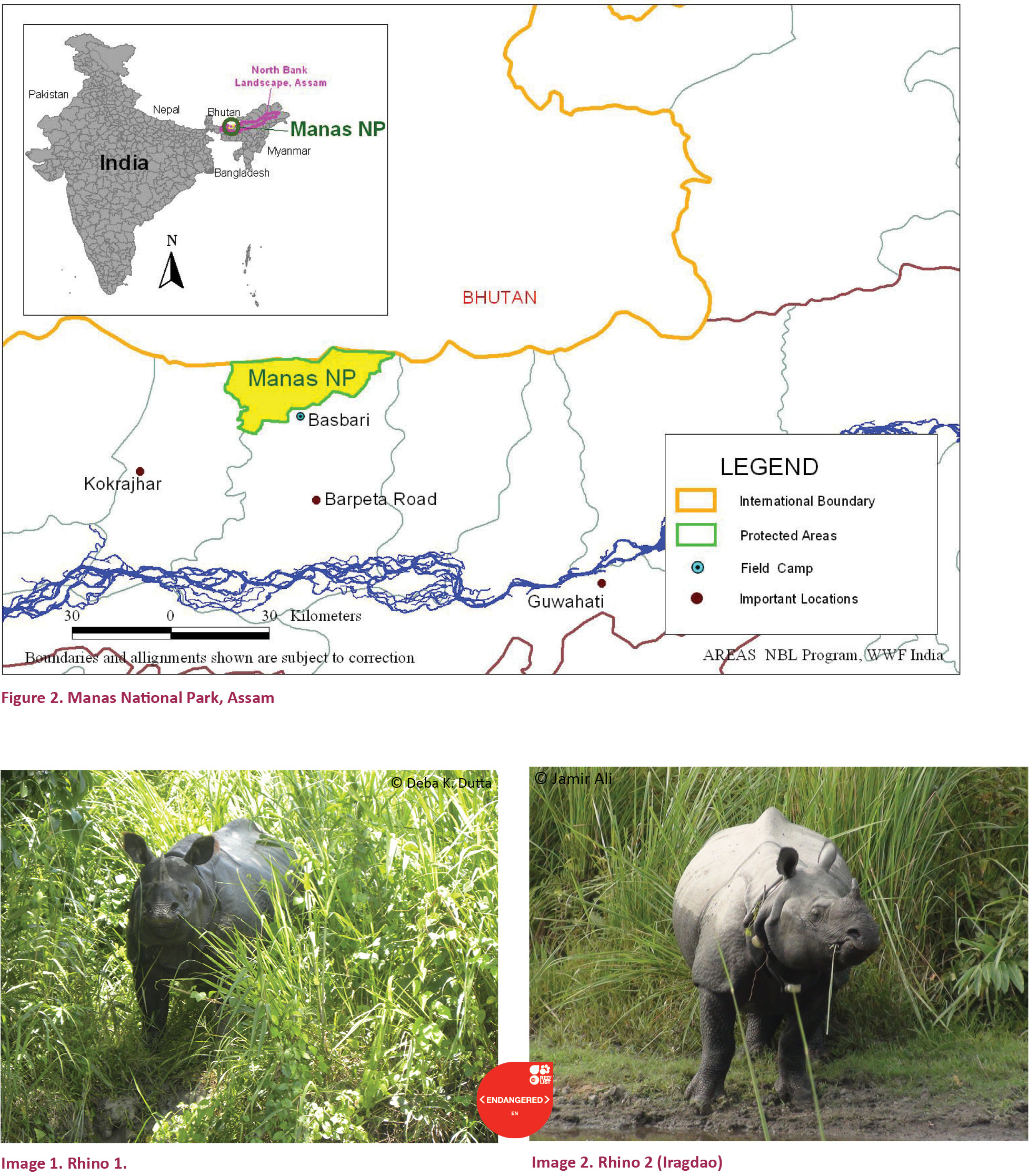
The entire Manas Tiger Reserve was also declared a Biosphere Reserve in 1989. Manas finally was declared as a National Park in 1990, when it was enlarged to 519.00km2 including the Manas Tiger Reserve (Fig. 2).
METHODS
Very High Frequency (VHF) radio collars (African Wildlife Tracking) were placed on rhinos prior to their release. Immediately after translocation, the rhinos were tracked and located at three times - daily morning, afternoon and evening (i.e., from 06.00—10.00 hr, 10.00—14.00 hr, and 14.00—18.00 hr). Sometimes rhinos were also located at night (i.e., 18:00—06.00 hr) which is largely dependent on accessibility factors. Tracking of the rhinos were carried out by using directional antennae on foot, elephant back, motorcycles or vehicles, depending on the area where the rhinos were present (Images 4–6). Focal observation was carried out using binoculars and spatial ancillary information was recorded with a handheld GPS unit (Gramin Inc.). The rhinos were translocated and released in six undertaken for the first three months post the release of each group of rhinos (Table 2).
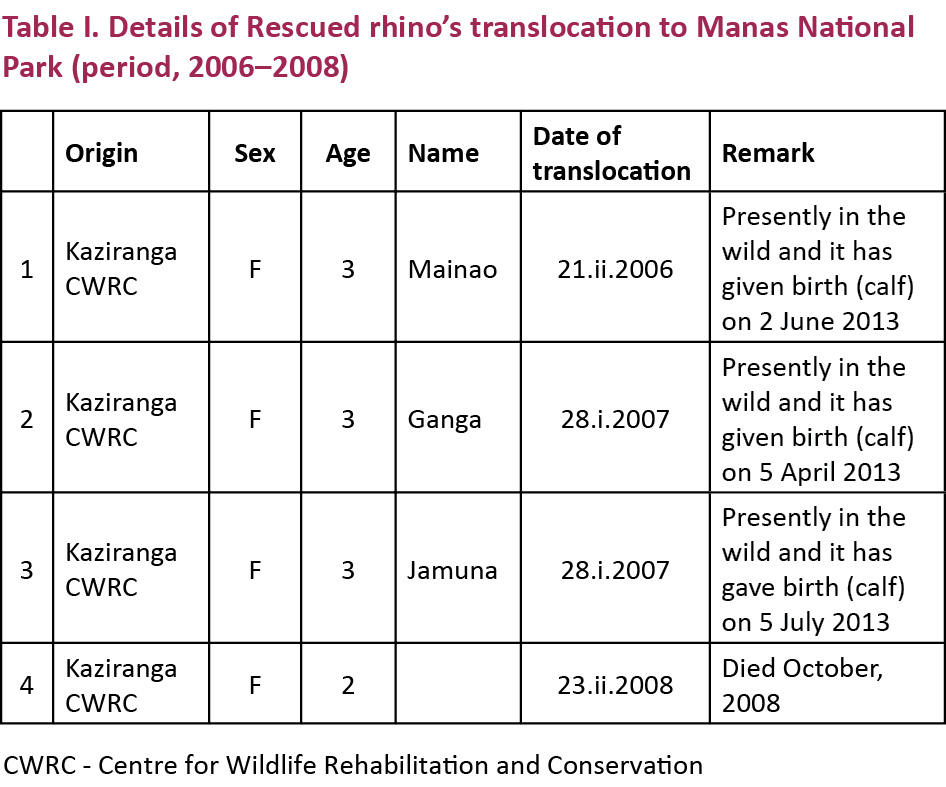
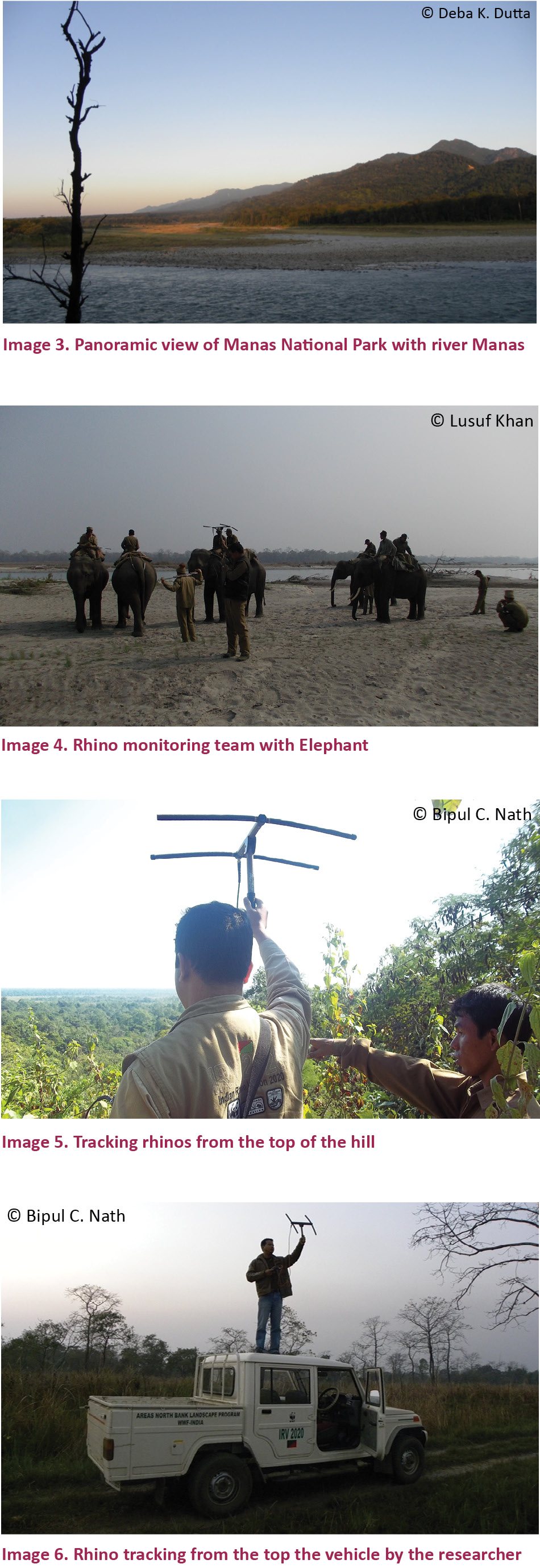
Focal all occurrences behavior sampling (Altman 1974) was conducted whenever a direct observation was possible. In the focal sampling all occurrences of specified actions of one individual were recorded during a predetermined sample of one hour. All occurrences sampling- as per this method we focused on a particular behavior rather than a particular animal. Behavioral categories were broadly defined as feeding, wallowing, walking and resting (Table 3). We have also recorded association pattern with other translocated rhinos and rescued, hand reared rhinos. Animals found in close proximity (within 10m) were recorded as an association (Patton et al. 2012). The rhino’s stray occurrences also were recorded during this period. All data were entered in Microsoft excel software. The colonization pattern of each group was analyzed with one way analysis of variance (single factor ANOVA). Chi-square goodness of fit test was performed to find out if there were any significant stray occurrences and behavioral aspects among the rhino groups.
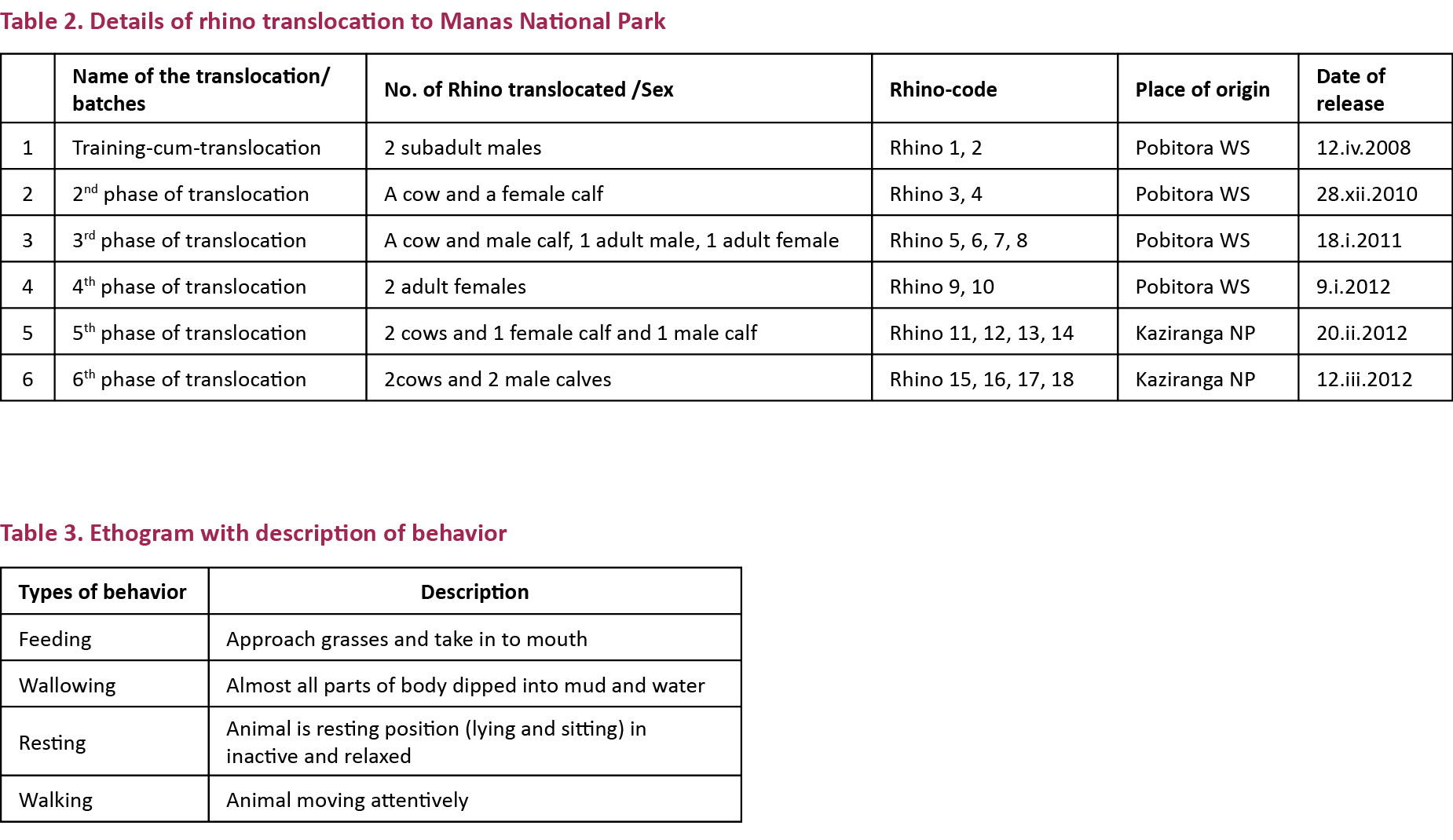
RESULTS
The results are based on our primary observation and tracking of rhinos. All rhinos were released in a release site at Buraburijhar of Bansbari range (Fig. 3) except the adult female Rhino 8. Rhino 8 was found to be pregnant so veterinarians suggested a soft release at the rhino enclosure near the Rhino camp but she moved outside immediately after release at the enclosure (Fig. 4).
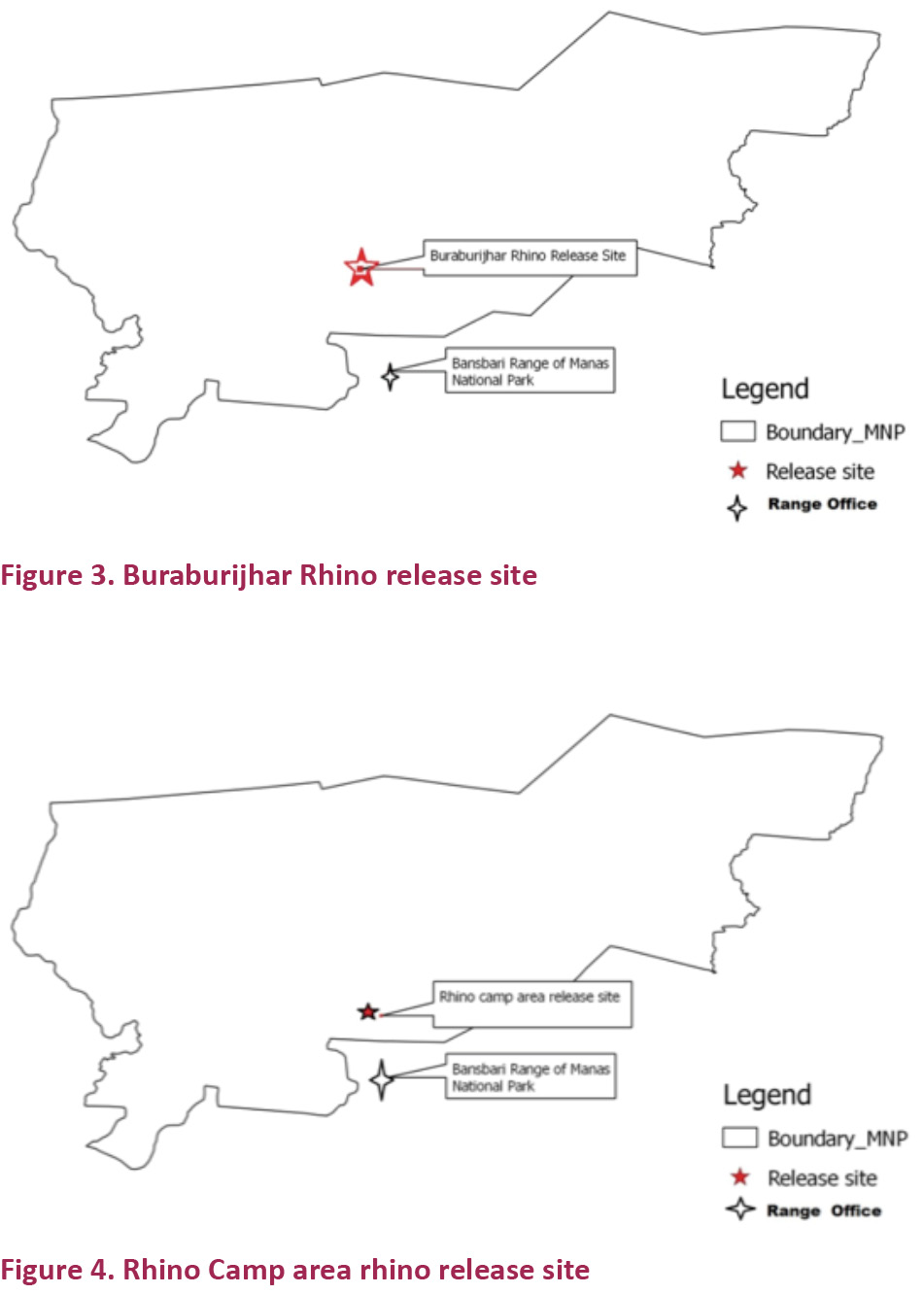
Distance Travelled from Release Site
After the release two individuals of the first group of translocated rhinos moved approximately 5km away from the release site (Sharma unpub. data). Groups of rhinos that were released subsequently moved an average of 3.1km from the release site. Out of the 18 rhinos released at Manas, 16 (89%) dispersed almost in the same direction towards the eastern bank of river Beki from the release site (Table 4). It was observed that all crates faced the northern direction so after release the rhinos directly reached Buraburijhar River which is situated just 100m away from the release site and through the river channel, all rhinos finally reached the eastern bank of River Beki.
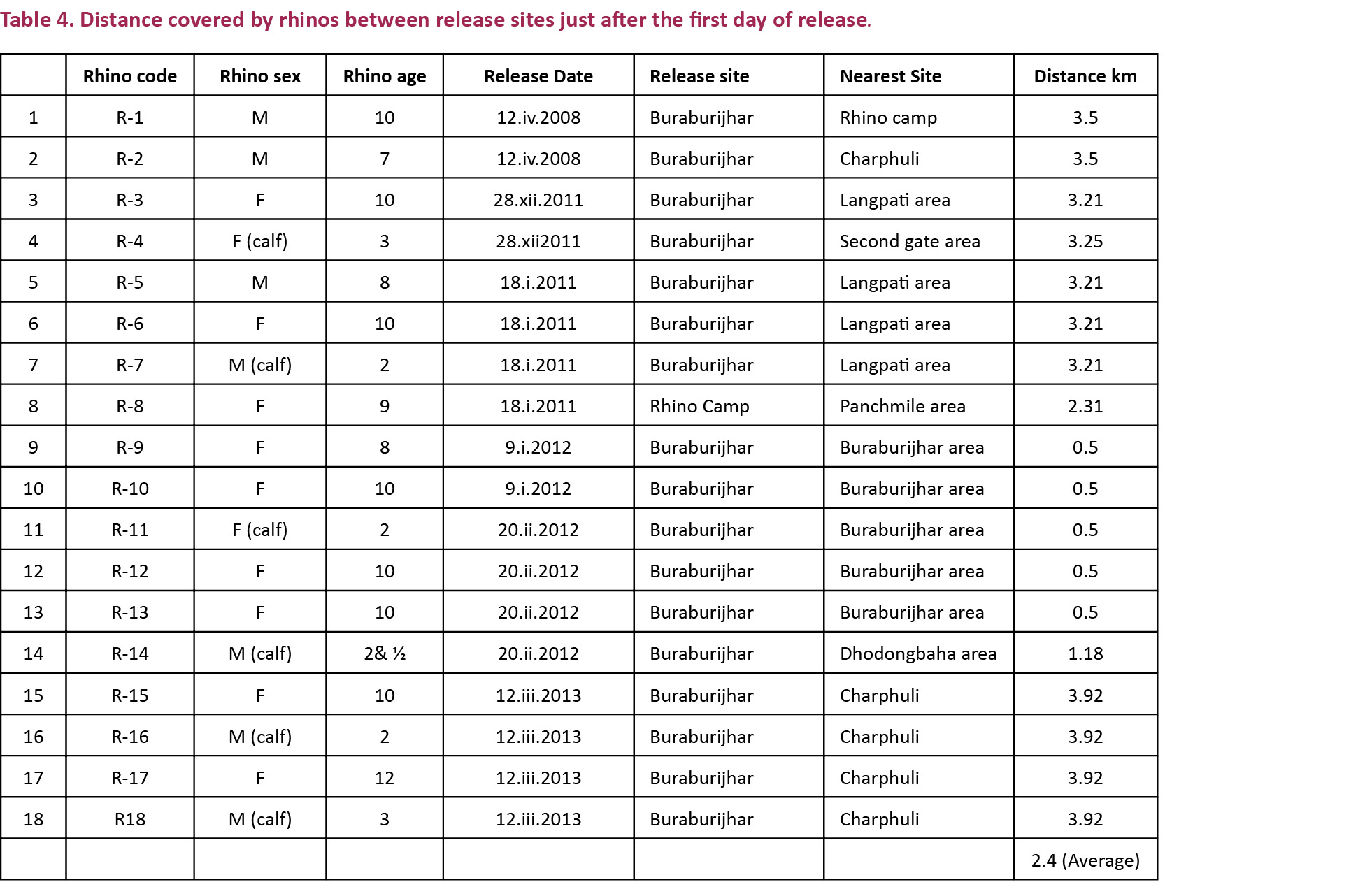
Pattern of colonization after release at Manas NP
To observe some short terms of fluctuation pattern, we studied each rhino’s movement at 10-day intervals. Similar studies have already been carried out by Patton and Cambell (2010) in Kenya for same day free release of Black Rhinos translocated.
In the first group, two sub adult male rhinos (R1 & R2) were released in MNP. During 90 days of observation period, these two rhinos were located 87% (n=273) of the time in Bansbari range and 13% (n=41) in Bhuyanpara range. There was no significance observed in their colonization pattern [F (20,32)=1.01, p=0.46], (Fig. 5).
In the second group, a pair - a mother (R3) (Image 7)and a female calf (R4) was released at Buraburijhar of Bansbari range. They were located 76% (n=193) of the time in the Bansbari range and 24% of the time (n=68) at Panbari areas. As per an analysis of data, there was a strong significance pattern of colonization observed in this group [F (12, 33)=4.1, p=0.006], (Fig. 6).
In the third group, one adult male (R5), a pair - comprising a cow and a calf (R6 & R7) and one adult female (R8) were released (Images 8–9). This group was located 90% (n=557) of the time at Bansbari area and 10% (n=62) of the time at Bhuyanpara range and the pattern of colonization was insignificant for this group [F (17, 75) =3.8, p=2.8], (Fig. 7).
In the fourth group, two adult females (R9 & R10) were released. They were located 46% (n=142) of the time in Bansbari range and 56% (n=72) of the time in Bhuyanpara range and the pattern of colonization found significance [F (16, 59) =1.9, p=0.02], (Fig. 8).
In the fifth group, two pairs of cow and calf (R11 &12 and R13 &14) were released (Image 10). This group was located 87.90% (n=291) of the time at Bansbari and 12.10% (n=40) of the time at Bhuyanpara range and the pattern of colonization was insignificant [F (22, 49)=1.1, p=0.3], (Fig. 9).
In the sixth group, two pairs of cow and calf (R15, R16, R17 & 18) were released. This group was located 83% (n=285) of the time at Bansbari and 17% (n=44) of the time at Bhuyanpara range and the pattern of colonization was significant [F (23, 191)=1.7, p=0.02] (Fig. 10). As per the colonization pattern, it was found that Bansbari range was preferable for all rhino groups than the Bhuyanpara and Panbari ranges.
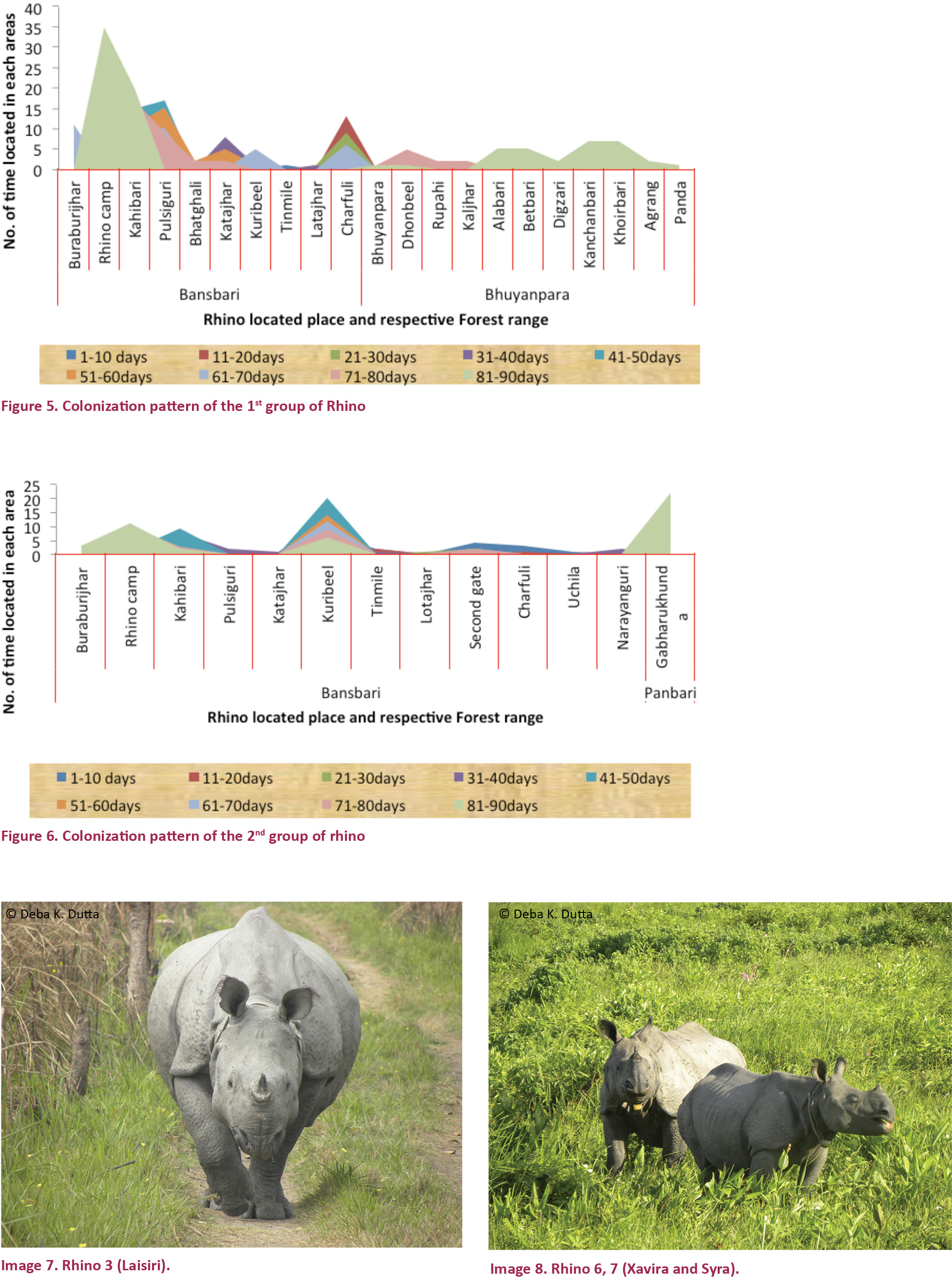
Behavior of Rhinos
In the first group (R1 & R2) consisting of two sub adults, we were able to observe the animal in 72% of attempted observations (n=491). In the second group (R3 & R4) consisting of a pair of females (a cow and calf), we successfully observed the dyad 44% of attempted observations (n=309). In the third group (R5, R6, R7 & R8) consisting of one adult male, a cow and calf and one adult female we successfully observed the animal during 65% of attempted observations (out of a total effort of n=678). In the fourth group, which consisted of two adult females (R9 & R10), we successfully observed the animals in 44% of attempted observations (n=226). In the fifth group consisting of two cow-calf dyads, we successfully observed the animals on 35% of attempted observations (n=490). In the sixth group consisting of two cow-calf dyads, we successfully observed the animals only 20% of the attempted observations (n=462). This group was difficult to observe because both pairs were using very difficult areas of Bansbari and Bhuyanpara range where it was not logistically possible to locate them every day.
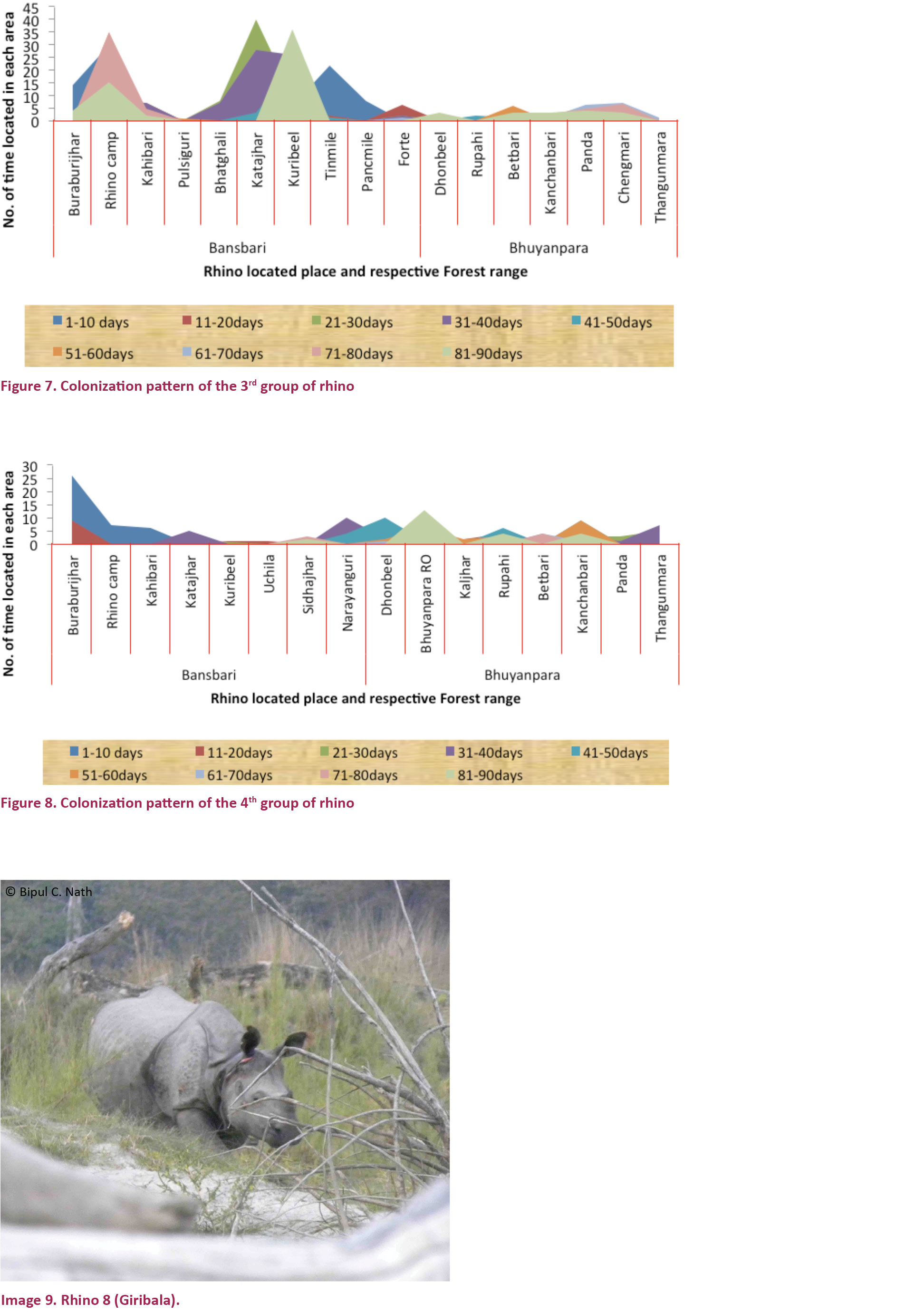
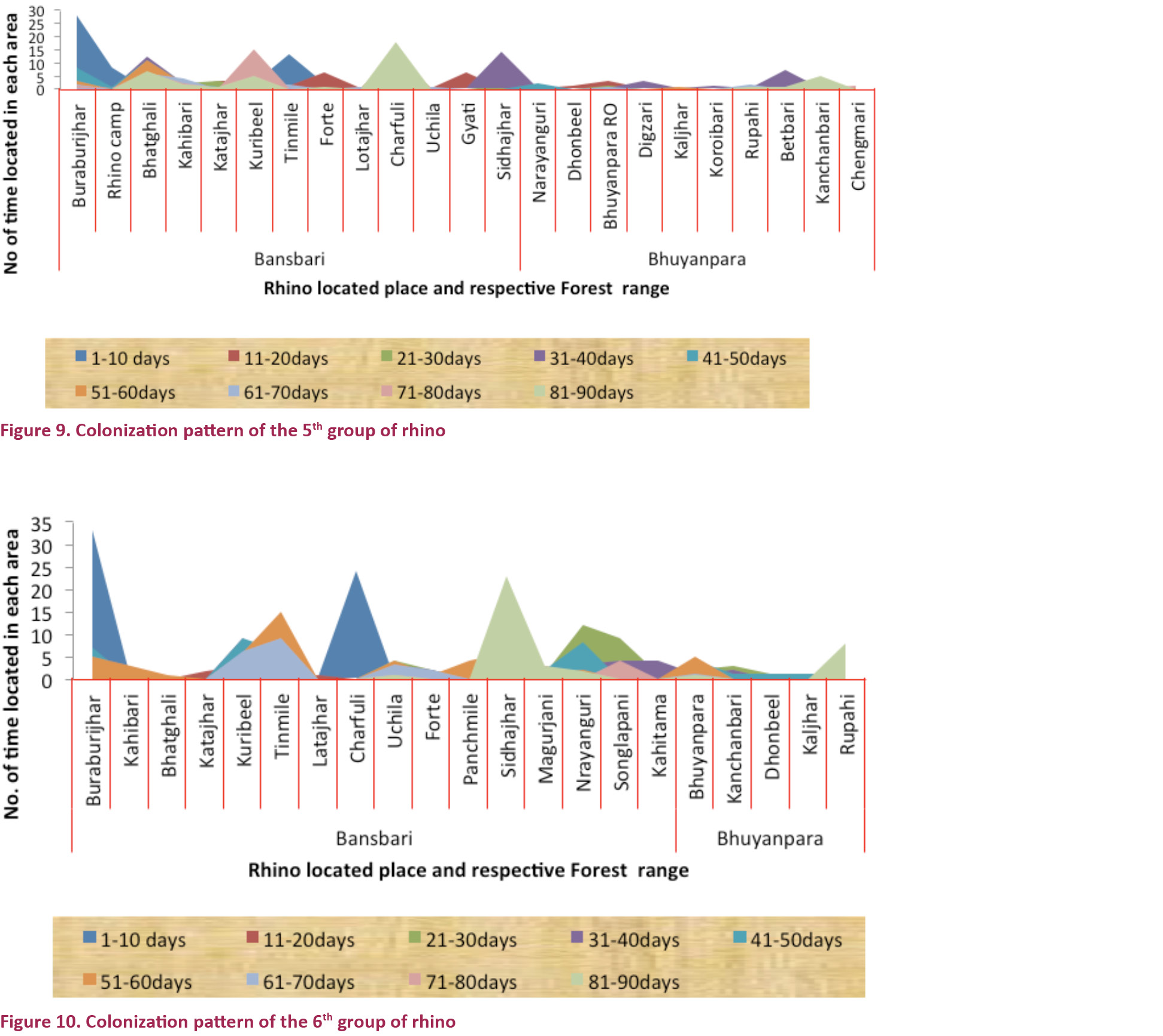
There were six adult females (R3, R6, R12, R13, R15 & R17) with calves. Adult females (with calf) that were devoted 54% of the time in feeding, 13% of the time in wallowing, 28% of the time in walking and 5% of the time in resting. Similarly, we had three adult females without calves (R8, R9 and R10) that spent 51% of the time in feeding, 15% of the time in wallowing, 23% of the time in walking and 11% of the time in resting. Adult females with calves spent more time on feeding and walking as compared to females without calf. But there was no significant difference found between the Adult female rhinos with calf or without calf (χ2=1.36, df=3, NS). (Fig. 11).
We had three adult male rhinos (R1, R2, R5), and they spent 47% of the time in feeding, 22% of the time in wallowing, 15% of the time on walking and 16 % of the time in resting. Although it was found that adult females spent more time in feeding and walking as compared to adult male rhinos whereas adult males were found to spend more time on wallowing and resting. But there was no significant difference found between the adult male and adult female rhinos without calf (χ2=5.28, df=3, NS) or with calf (Fig. 12).
We had six calves and they devoted 48% of the time in feeding, 14% of the time in wallowing, 28% of the time in walking and only 10% of the time in resting. Both male and female calves got separated from their mother when any adult bull was in close proximity. So, they spent more time on walking and exploring new areas after their release. When we compared adult males, adult females and calves behavior we did not find any significant changes (χ2=5.86, df = 6, NS) (Fig. 13).
Rhinos were found feeding early in the morning and late in the afternoon. Wallowing was the prime activity during noon in shallow waterholes containing mud and water. In case of resting the rhinos preferred being inside wood land and bushy areas.
Straying of Rhinos
Just after their release in MNP, some rhinos wandered and entered fringe villages of the national park. A few individuals strayed outside to adjacent paddy fields. They fed on the crops and also damaged them by walking inside the cropping areas.
Rhino straying is a very common occurrence in Pobitora WS, the source for some of the translocated rhinos. About 25–30 % of rhinos living in Pobitora stray out from the core zone of the park to forage in the surrounding villages at night (Talukdar 1999). This might contribute to the rhinos released from PWS straying more frequently than those from KNP. Significantly, rhinos translocated from PWS (91.6%) had more straying occurrences than the rhinos from KNP (8.4%) (χ2=35.19, df=1, p<0.05), (Fig. 14 ).
The first group of rhinos strayed several times (n=67). The second group strayed only once (n=1). The third group strayed nine times (n=9), the fourth group of rhinos strayed ten times (n=10) while the fifth and sixth groups strayed four times (n=4) each. Significantly, straying of the first group occurred more number of times than any other group (χ2=202.07, df=5, p<0.05)(Fig. 15).
Straying of the Greater One-horned Rhinos from protected areas to fringe villages is commonly observed mainly for reasons such as increased biotic pressure on protected habitats resulting in degradation of the habitat. Some of the rhinos in Pobitora are habituated with straying for crop raiding in fringe areas (Dutta et al. unpublished). It was assumed that the first group’s two male rhinos might be habitual crop raiders so we found more stray incidents with them than later groups of rhinos released in MNP. Another fact was that the first group of rhinos liked to use grazing areas of domesticated cattle and buffaloes near the southern boundary and eventually outside the park along with cattle and buffaloes in the evening.
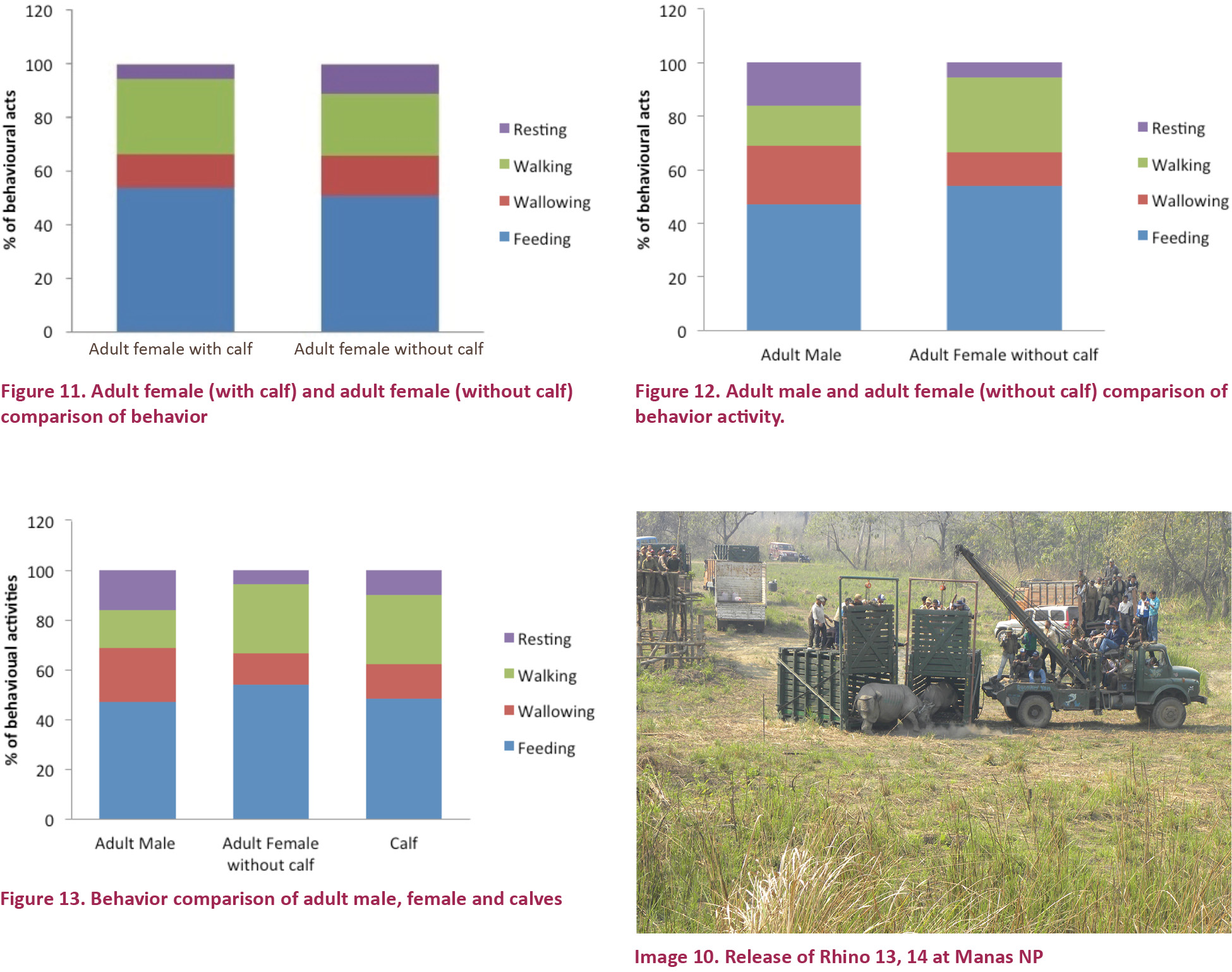
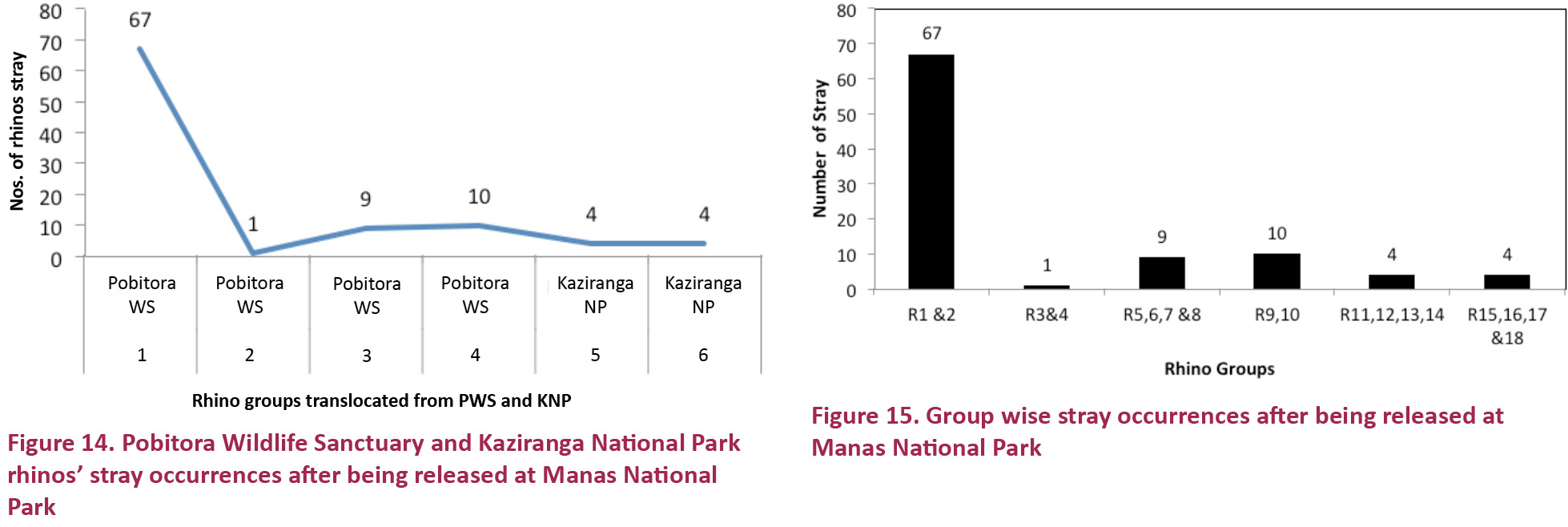
Straying incidents occurred on an average of 15 days after release; and always occurred early in the evening or late at night. While straying, the rhinos tried to enter paddy fields, vegetable farms and orchards; they also raided crops and sometimes entered waterholes near tea gardens adjacent to the Bansbari range. Only seven of the 87 straying incidents occurred after midnight; the majority of straying incidents occurred from the hours of 17.00hr to 22.00hr for all the groups of rhinos. Sometimes, accidental separation of cows and calves led to straying. For example, cow 17 and her calf R18 became separated 15 days post-release, straying in two different directions. The separated cow and calf created chaos in a village 12km away from the MNP and in an attempt to reunite, one person was killed the next day. However, both the rhinos entered the park that same night and afterwards they only strayed in very close proximity of the park boundary where water holes were available. Rhino-3 also strayed outside once, near the Bansbari range entry point after she also was separated from her calf, 26 days after release.
Discussion
This was the first wild to wild rhino translocation programme in the conservation history of Assam. This study is one of the first on colonization patterns and post- translocation behavior for Greater One-horned Rhinos. Observations confirmed that the Bansbari range was preferred by all the groups of rhinos after release at Manas. Twenty-eight days after release, the rhinos were seen moving to other two ranges (i.e., Panbari and Bhuyanpara) by crossing even big rivers like the Beki and Hakuwa. This indicates that even small rhino calves (2 years old) can swim across fast flowing rivers. During the first 25–30 days post-release, all the rhinos colonized different places within Bansbari; it was not until after this time that some rhinos went exploring the Panbari and Bhuyanpara ranges. Eight of the 18 rhinos used the central part of the Bansbari range; five rhinos moved to Bhuyanpara range; four rhinos moved to the western part of Bansbari and only one rhino reached the Panbari range crossing river Beki during the study period.
Before the release of the first group of rhinos in Manas, about 300kg of dry rhino dung was carried from PWS and was spread around the Buraburijhar. We did this so that the released rhinos become accustomed to dung middens, which we had hoped would prevent them from wandering too far after release. This seemed to reduce the movement of two rhinos (i.e., R1 & R2). As later groups of rhinos were released, it is possible that the gradual decrease of the first day’s movement of each group might be because of the presence of previous groups of rhinos and the presence of five large dung heaps around the Buraburijhar areas and perennial water sources.
Although rhinos are not regarded as social animals, they appeared to demonstrate some affinity observed after release at the new site. The first two translocated sub-adult male rhinos remain solitary but strayed together after 40 days from release at new home. There was no sign of aggression observed between them. This is similar to what has been seen in other rhino species. Black Rhinos released in Mun-ya-Wana Game Reserve in Africa also showed no evidence of aggression or fighting during the first few days after release (Linklater et al. 2006). Similarly, no aggression was observed on the same day released translocated black rhinos in Kenya (Patton et al. 2010), according to Linklater & Swaisgood (2008), the death of black rhinos post -release was more closely related to recipient reserve size and release density rather than the interaction of sex and age and the presence of resident conspecifics.
There were six cow-calf dyads among the translocated rhinos released in MNP. Among them, two cows had female calves and four had male calves. At release two crates were used for transporting so that the cow and calf could continue their bond. But, most likely because of confusion associated with being moved to a new site, almost all the dyads separated just after release. All the cows and calves reunited within 24 hours after release. But it was observed that the cows showed an affinity towards male calves whereas cows that had female calves had very loose bonding. A strong relationship between a cow and calf is vital as the cow would be aggressively protective of the calf in any new home land (Patton et al. 2010). Rhino 3 with her female calf (R4) was released simultaneously but they were separated just after release and reunited the same day evening. After 26 days, they were completely dissociated and the calf moved to the Panbari range by crossing the Beki River. A similar thing was also observed with adult cow R12 with her calf R11. Both of them dissociated just after 25 days from release. This could also be attributed to the fact that Rhino 2 (adult male) tried to overpower the female calves and they were scared and moved away to a safe distance. The female calf R11 was only two years old at the time of release. Twenty-four days post-release the dominant male R2 was trying to mount her at a swampy area in the evening. The sexually immature female calf got stuck in the deep mud and was unable to move. Fortunately, the rhino monitoring team got the noises of the female calf and chased the male rhino away with a search light and saved her life. After two days of instance, the calf moved to the Kahitama area by crossing the Beki River.
Significantly, an association of an adult cow with a male calf was very prominent. The adult cow R6 with male calf R7 used the same locations till the end of the study period. A similar behavior was also noticed in the other three adult cows and calves: R13 (cow) - R14 (male calf), R15 (cow)- R16 (male calf), R17 (cow)- R18 (male calf).
Association with hand reared female Rhinos
Four rescued, hand reared rhinos were rehabilitated at the rhino camp enclosure during the first phase of rhino translocation. Fifty-eight days post release, one subadult male R1 entered the Boma by breaking the rhino enclosure. All rhinos were female and they did not tend to move outside the enclosure. Since release, they were accustomed to electric shock of solar electric fence wire surrounding the Boma. However, another male R2 occasionally visited the enclosure but did not enter it.
Association with other wildlife and domesticated cattle
Just following release, the rhinos were seen having a few associations with other wild animals. There were some variation observed among the rhinos released from two source populations, i.e., KNP and PWS. Rhinos translocated from PWS were found to be in close affinity with domesticated cattle and wild buffalo (n=34) and gaur (n=8). A sub adult male R2 liked to share gazing space with one injured gaur just after release. Later, both the two male sub-adult rhinos were united and shared their space with domesticated cattle and buffalo near the southern boundary of Bansbari and Bhuyanpara ranges. These animals (R1 and R2) were observed 44% of the time (out of a total observation n=354) in association with domesticated cattle. A similar affinity with domesticated cattle was also observed with R3 about 4.45% of the time (out of a total n=136); R6 & R7 were observed with cattle for about 4% of the time out of a total observation of (n=254); R5 was observed with cattle for about 3.2% of the time (out of a total n=152); R8 was observed with domesticated cattle for about 3% of the time (out of a total observation of about n=243); R10 was observed with domesticated cattle for about 31% of the time (out of a total observation of n=64). Rhino-11 after reaching Kahitama (the western part of Bansbari Range) area liked to use the same grazing space with one thousand domesticated buffalo and cattle inside the park. However, R11 was found only 8% of the time in association with domesticated cattle (out of a total of individual observations n=147).
Except for the sub-adult rhino R11, there were no such associations observed with rhino translocated from KNP. Around 2,500–3000 cattle graze in the core of PWS every day in association with wild rhinos (Talukdar 1999). Rhinos from Pobitora may have more familiar association with cattle as compared to KNP, where there are minimal rhino and domesticated cattle associations due to strict protection and the nature of terrain like swamp and marshy areas, beels, undulating hill sides etc.
Conclusion
Wild to wild rhino translocation in Assam thus far is on track to meet Indian Rhino Vision 2020 goals for achieving the goal of 3000 rhinos by the year 2020. The success of monitoring rhinos during the first 90 days of release in MNP opened a new dimension in the history of rhino conservation in Assam. There has been little research into free release rhino translocations and this was the pioneering effort in Assam. In other rhino species, there is a great variation in the performance of individual rhinos after translocation and release. (Hofmeyr et al. 1975; Hall-Martin & Penzhorn 1977; Hitchins 1984; Adcock et al. 1998; Brett 1998; Patton et al. 2010). The success of a translocation can be improved with a better understanding of how rhinos behave after release, particularly how much they move, relative to their release site and their pattern of movement in the landscape during early stages of establishing a home range (Linklater et al. 2003). The present study will be helpful in future efforts of greater one horned rhino translocation on recipient site. It was observed that within the 90 days period of translocation, rhinos were settling in on different locations of Manas National Park. So anti-poaching measures were strengthened around these areas.
Release sites must be kept out of disturbance. Transporting vehicles must be parked at least 500m away from the release site. After release, intensive monitoring and patrolling is necessary to track the whereabouts of the rhinos, but with minimum human disturbance. As per colonization patterns observed in Manas, the newly released rhinos immediately required water bodies and surrounding grassland near to the release site. Therefore, release sites must be selected around locations with neighboring water bodies, grass land and far inside the park boundary. It is necessary to conduct rhino monitoring through properly trained rhino monitoring staff with trained patrolling elephants. During our study period, some elephants as well as Mahout (elephant driver) were not well trained for monitoring rhinos. Some elephants were also scared of approaching the rhinos. So just before translocation, recipient sites must develop capacity in this regard. It was observed that the dominant bull (R1 & R2) might influence on the colonization pattern of female calves and sub adult males. Proper observation of such behavior is necessary after release. All recipient sites must be ready with requisite logistics (crates, darting gun, drugs, etc.) to tackle any emergency situation like rhino straying out of the park.
References
Adcock, K. H.B. Hansen & H. Lindemann (1998). Lessons from the introduced Black Rhino population in Pilanesbug National Park, Pachyderm (26): 40–51.
Altmann, J. (1974). Observational study of behavior sampling methods. Behavior (49): 227–267; http://dx.doi.org/101163/156853974 Xoo543
Barman, R., B. Choudhury, N.V.K. Ashraf & V. Menon (2014). Rehabilitation of Greater One-horned Rhinoceros calves in Manas National Park, a World Heritage Site in India. Pachyderm (55): 78–88.
Bhima, R. & C.O. Dudley (1996). Observations on two introduced Black Rhinos in Liwonde National Park, Malawi. Pachyderm (21): 46–54.
Bonal, B.S., A. Sharma, D.K. Dutta, A. Swargowari & C.R. Bhobora (2008). An Account of released rhinos in Manas National Park (April-September, 2008), Translocation Core Committee, Indian Rhino Vision (IRV), 2020, Govt. of Assam, India.
Bonal, B.S., A. Sharma, D.K. Dutta, A. Swargowari & C.R. Bhobora (2009). An account of the released rhinos in Manas National Park, Assam (October 2008 - March 2009), Translocation Core Committee, Indian Rhino Vision (IRV), 2020, Govt. of Assam, India.
Bonal, B.S., B.K. Talukdar & A. Sharma (2008). Translocation of Rhino in Assam, Tiger Paper (36): 1, Jan–March.
Brett, R.A., (1998). Mortality factors and breeding performance of translocated Black Rhino in Kenya 1984–1995. Pachyderm (26): 69–82.
Dutta, B., B. Choudhury, A. Talukdar, M.L. Smith & U. Shukla (2009). Formulating a working protocol for unusual cases of translocation based on experiences of three cases in India, (Unpublished report)
Dutta, K.D., A. Sharma, A. Swargowari, C.R. Bhobora, B.S. Bonal, D. Ghose & C. William (2012). How many locations do we need per day to reliably describe the habitat use of translocated rhino in Manas NP? Journal of Natural Science Research 2: 3.
Emslie, R.H., R. Amin & R.H. Kock (2009). Guidelines for the in situ Reintroduction and Translocation of African and Asian Rhinoceros First Edition. Occasional Paper of the IUCN, Species Survival Commission (39): 95–97.
Foose, T.J.F & N. van Strien (eds.) (1997). Asian Rhino Status Survey and Conservation Action Plan, IUCN/SSC Asian Rhino Specialist Group IUCN, Cambridge UK.
Gillison, A.N. (2004). Biodiversity Assessment in North Bank Landscape, North East India WWF-India
Gottert, T., S. Joachim, D. Zinner, J.K. Hodges & M. Boer (2010).Habitat use and spatial organization of relocated Black Rhinos in Namibia. Mammalia 74: 35–42; http://dx.doi.org/10.1515/mamm.2010.012
Griffaith, B., J.M. Scott, W.J. Carpenter & C. Reed (1986). Translocation as a species conservation tool: status and strategy. Science (245): 477–479; http://dx.doi.org/10.1126/science.245.4917.477
Guy, D. & H. Lethier (2008). Mission Report, Reactive Monitoring Mission to the Manas Wild lilfe Sanctuary, India from 12 to 18 February, 2008, UNSECO World Heritage Centre IUCN, 7pp.
Hall-Martin, A.J. & B.L. Penzhorn (1977). Behavior and recruitment of translocated Black Rhinoceros (Diceros bicornis). Koedoe (20): 147–162; http://dx.doi.org/10.4102/koedoe.v20i1.941
Hitchins, P. (1984). Translocations of Black Rhinoceros (Diceros bicornis minor) from Natal Game reserves (1962–83). The Lammergeyer 33: 45–48.
Hofmeyr, J., H. Ebedes, R. Fryer & J. de Bruine (1975). The capture and translocation of the Black Rhinoceros (Diceros bicornis) Linn. In South West Africa, Madoqua 9: 35–44.
Jnawali, S.R. (1995). Population ecology of Greater One-horned Rhinoceros (Rhinoceros unicornis) with particular emphasis on habitat preferences on food ecology and ranging behavior of a reintroduced population in Royal Bardia National Park in lowland Nepal. PhD Thesis, Agriculture University of Norway, Oslo.
Linklater, W.L. (2003). Science and management in a conservation crisis: a case study with rhinoceros. Conservation Biology 17(4): 968–675; http://dx.doi.org/10.1046/j.1523-1739.2003.01449.x
Linklater, W.L. & R.R. Swaisgood (2008). Reserve size, conspecific density and translocation success for Black Rhinoceros. Journal of Wildlife Management 72: 1059–1068; http://dx.doi.org/10.2193/2007-398
Linklater, W.L., J. Flamand, Q. Rochat, N. Zekela, E. MacDonald, R. Swaisgood, D.C.P. Airton, C.P. Kelly, K. Bond, I. Schmidt & S. Morgan (2006). Preliminary analyses of the free release and scent-broadcasting strategies for Black Rhinoceros reintroduction. CCA Ecological Journal 7: 26–34.
Lucy, V. & E.B. Martin (1994). The Greater One-horned Rhino of Assam is threatened by poachers. Pachyderm 18: 28–43.
Olson, M.D.& E. Dinerstein (2002). Global 200: priority eco regions for global conservation. Annals of the Missouri Botanical Garden 89: 199–224
Patton, J.F., M.S. Mulama, S. Mutisya & P.E. Campbell (2010). The colonization of a new area in the first six months following ‘same day’ free release translocation of Black Rhinos in Kenya. Pachyderm 47: 66–79.
Patton, F.J. & P.E. Cambell (2010). Eighteen-month update on the movement s and social organize of a population of Black Rhinos introduced to a new area by ‘same day’ free release translocation in Kenya. Pachyderm 48: 71–72.
Sharma, A., D.K. Dutta, A. Swargowari & S.P. Singh (2012). Released Rhinos in Manas National Park-The Fourth Year (April 2011–March 2012), Translocation Core Committee, Indian Rhino Vision (IRV), 2020, Govt. of Assam, India.
Sharma, A., D.K. Dutta, M.G. Das & J. Ali (2008). Tracking the rhinos in their new habitat - notes from the field (Unpublished report), 3pp.
Singh, D.M., A. Sharma, D.K. Dutta, A. Swargowari, C.R. Bhobora & B.S. Bonal (2011). An Account of released rhinos in Manas National Park-The Second Year (April 2009 - March 2011). Translocation Core Committee, Indian Rhino Vision (IRV), 2020, Govt. of Assam, India.
Singh, S.P, A. Sharma, D.K. Dutta, A. Swargowari, C.R. Bhobora & D.M. Singh (2011). An Account of released rhinos in Manas National Park-The Third Year (April 2010 - March 2011). Translocation Core Committee, Indian Rhino Vision (IRV), 2020, Govt. of Assam, India.
Talukdar, K.B. (1999). Status of Rhinoceros unicornis in Pobitora Wild Life Sanctuary, Assam. Tiger Paper 1: 8–10